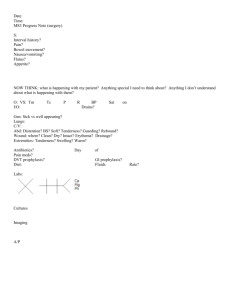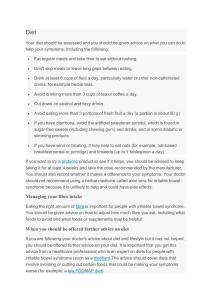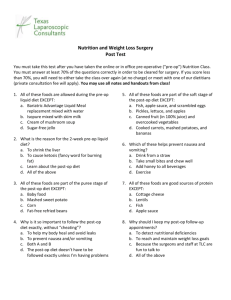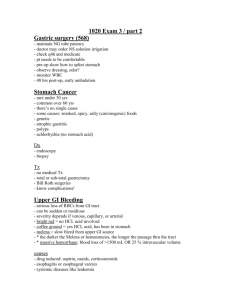Alterations of GI System
advertisement
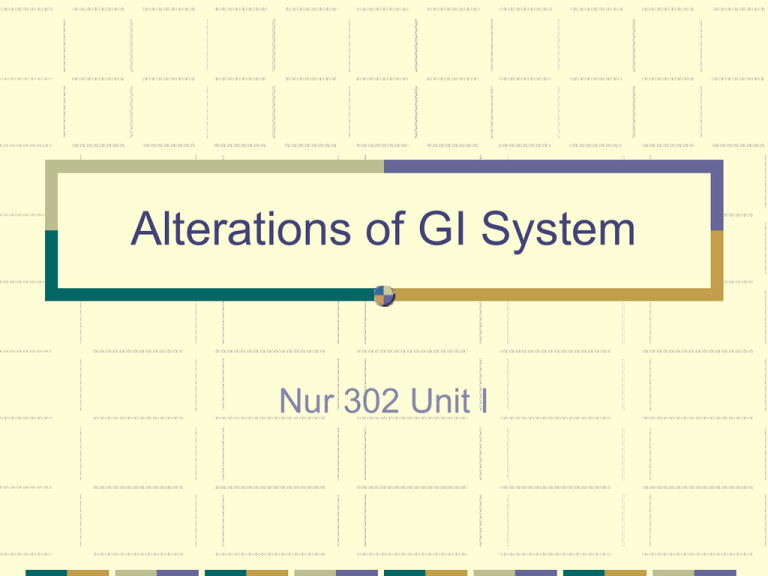
Alterations of GI System Nur 302 Unit I Carcinoma of Oral Cavity Predisposing factors: tobacco & alcohol S/S: leukoplakia, erythroplakia, ulcer, sore or rough spot Diagnosis: biopsy Collaborative Care: surgery, radiation, chemo or combination Health Promotion Expected Outcomes Mandibular Fracture Rx: immobilization by wiring- 4-6 weeks Pre-op teaching Post-op Care: Airway, oral hygiene, communication, nutrition Nausea & Vomiting Problems- Dehydration, loss of electrolytes, decreased plasma volume, metabolic alkalosis,aspiration. History, regurgitation, projectile, fecal odor, partially digested food, color, time of day, emotional stressors. Antiemetics, med’s that stimulate gastric emptying IV and NG tube, begin diet with clear liquids. GERD Predisposing Factors Hiatal hernia Incompetent lower esophageal sphincter Decreased esophageal clearance Decreased gastric emptying. Esophagitis- trypsin & bile salts. Hiatal Hernia Etiology Weakening of diaphragm muscles, increased intraabdominal pressure, age, trauma, poor nutrition, recumbent position. Types: Sliding & Paraesophageal or rolling. Complications: hemorrhage from erosion, stenosis, stomach ulceration, strangulation hernia, esophagitis. Treatment : See GERD, elevate HOB on 4-6” blocks, lose weight. GERD & Hiatal Hernia Signs & Symptoms Heartburn Wheezing, coughing, dyspnea Hoarseness, sore throat Post eating bloating N/V, regurgitation Hiatal hernia s/s mimic GB disease, angina, peptic ulcer Diagnostic Studies Barium swallow Esophagoscopy Biopsy Esophageal motility studies Check ph GERD & Hiatal Hernia Treatment Med’s: Antacids, H2-Blockers, Prokinetic drugs, Antisecretory drugs. Nutritional Therapy: diet high in P & low in Fat, avoid milk, chocolate, peppermint, coffee and tea, small frequent meals, avoid spicy foods and late meals. Teaching: avoid smoking, decreased stress, do not lie down three hours after eating. Hiatal Hernia Treatment Surgery: valvuloplasties or antireflux procedures. Post-op care: Prevent respiratory complications maintain fluid & electrolyte balance prevent infection. Chest tube NG tube. Esophageal Cancer Barrett’s esophagus/syndrome. Etiology: smoking, alcohol, chronic trauma, poor oral hygiene, asbestos. S/S: progressive dysphagia, late s/s pain. Complication: hemorrhage, mets to liver and lung. Treatment: surgery, radiation, & chemo. Esophageal Cancers Pre-op care: high calorie, high P, liquid diet or TPN oral care teaching Post-op care : NG bloody 8-12 hours semi-Fowler’s position prevent resp. complication Gastritis Types: Acute or Chronic, Type A (Fundal) & Type B (Antral). Etiology: breakdown in normal mucosa barrier Corticosteroids, NSAIDS, ASA,spicy foods, alcohol Presence of Helicobacter pylori Gastritis Signs & Symptoms Anorexia N/V Epigastric tenderness Feeling of fullness Hemorrhage Diagnostic Studies Endoscopic exam CBC Stool for occult blood Cytologic exam Gastritis Treatment: eval. & eliminate the specific cause, double & triple antibiotic combinations for H. pylori, no smoking, bland diet. Assessment: dehydration, vomiting, hemorrhage. Teaching: stress close medical followup, diet, meds. Peptic Ulcers Types: acute or chronic, gastric or duodenal (80%). Person with a gastric ulcer has normal to less than normal gastric acidity compared with a person with a duodenal ulcer. Etiology: H.pylori disrupted mucosal barrier, increased vagal nerve stimulation (eg. emotions), genetic, medications Peptic Ulcer Signs & Symptoms May have no pain Gastric ulcer pain epigastric, burning, “gassy” 1- 2 hrs after meals, stomach empty or when eat food Duodenal ulcer pain back or mid-epigastric, burning, cramp-like 2-4 hrs after meals, antacids relieve pain Peptic Ulcers Complications: hemorrhage, perforation, gastric outlet obstruction. Diagnostics: fiberoptic endoscopy, H.pylori tests, barium contrast studies, gastric analysis, CBC, urine analysis, liver enzymes studies, serum amylase, stool for occult blood. Conservative therapy: (see gastritis). Nursing Care Acute care: NPO, NG, IV fluid,v/s qh till stable Hemorrhage: assess color of hematemesis, s/s shock. Perforation: assess for sudden severe pain to abd. & shoulder, rigid abdomen, decreased or absent B.S. Surgical Therapy Partial gastrectomy Billroth I – Gastroduodenostomy, removes distal 2/3 stomach & attaches to duodenum Billroth II – Gastrojejunostomy, removes distal 2/3 stomach & attaches to jejunum Vagotomy-eliminates stimulus for acid secretion Pyloroplasty –enlarges pyloric sphincter, increases gastric emptying Post-op Care Observe NG tube drainage Red, decreasing in color 1st 24 hours Observe for clogged NG tube Do not irrigate without MD order, surgeon replaces NG if pt pulls out tube Observe for decreased peristalsis I&O, VS Post-op Care Observe for bleeding/ hemorrhage, NG & dressing Pain management What are the general post-op complications & nursing care? If you do not have HCl, what disease are you at risk for? Case Scenario & Prioritization BK is post-op Bilroth I and is to receive 2 units of blood. As you get out of report, lab calls and says the first unit of blood is ready. Prioritize: Verify order to transfuse blood and consent Take initial set VS Pick up blood from lab Assess IV site Start transfusion Verify pt ID, & blood compatability Prioritization Pre-transfusion T98.6, P80, R18, BP136/78. Transfusion started, slow …..15 minutes later- T98.2, P90, R22, BP 130/70, no itching, rate increased 100/h……20 minutes later- skin flushed, p 120, R32, BP100/60, c/o chest pain & chills. Priority problem??? What do you do first? Prioritize: Stop transfusion Save transfusion unit Inform MD/RN Save next voided specimen Start 0.9NS Take VS Post-op complications Dumping Syndrome Postprandial hypoglycemia Bile reflux gastritis Dumping Syndrome Large amount hyperosmolar chyme in intestine->fluid is drawn in->decrease of plasma volume Bowel also becomes distended>increased motility 15-30 minutes after eating->s/s last 1 hr Weakness, sweating, dizzy, cramps, urge to have BM Postprandial Hypoglycemia Like dumping syndrome 2 hours after eating Bolus of high CHO fluid into small intestine->bolus of insulin secretion>hypoglycemia What are the s/s of hypoglycemia? Bile Reflux Gastritis Alkaline gastritis from bile salts Continuous epigastric s/s which increase after meals & relieved by vomiting (temporarily) Treatment – Questran ac or pc, Aluminum hydroxide antacids Nutrition Postgastrectomy Dumping Syndrome Six small meals Do not have fluids with meals Fluids 45 minutes before or after meals Dry foods low CHO, moderate protein & fats Avoid concentrated sweets (jams, candy, etc) Lie down after meals, short rest period Ca of the stomach Etiology: smoked, spicy, highly salted foods may be carcinogenic, genetics, Type A blood, p.anemia, polyps. S/S of anemia, peptic ulcer disease, or indigestion. Diagnostics: CEA test, stool and gastric analysis, CBC, liver enzymes, amylase, barium studies, endoscopic exams. Surgery: (see peptic ulcer disease). Radiation & chemo Food Poisoning S/S: n/v, diarrhea, colicky abdominal pain Types: acute bacterial gastroenteritisstaph, clostridial, salmonella, botulism, escherichia coli, see table 42-27 Food Poisoning Health Promotion Correct food preparation Cleanliness Cooking Refrigeration Diarrhea “Symptom”, acute or chronic Etiology: decreased fluid absorption, increased fluid secretion, motility disturbance. Dx studies: H&P, labs, endoscopy Care: replace fluid & lytes, decrease # stools, treat cause, meds Acute Infectious Diarrhea Assessment: freq & duration, char & consistency, laxatives, antibiotics, diet travel, stress, family history, food prep VS, ht & wt, skin turgor, skin breakdown BS, distention, abdominal tenderness Nsg Care: hand washing, contact isolation, teach pt & family Constipation Etiology: insufficient dietary fiber, inadeq fluid intake, meds, little exercise Complications: hemorrhoids, Valsalva’s maneuver, diverticulosis Teaching: 20 – 30 g of fiber/day, drink 3 qts/day, exercise 3X/week, avoid laxatives/enemas, record elimination pattern, do not delay defecation & establish a pattern “Acute Abdomen” Etiology: see table 43-12 S/S: PAIN, abd tenderness, vomiting, diarrhea, abd tenderness, constipation, flatulence, fatigue, fever, increased abd girth DX: H&P, preg test, rectal & pelvic exam, CBC, U/A, abd x-rays Emergency management: table 43-13 “Acute Abdomen” Assess: VS, inspect, palpate & auscultate abdomen, pain, n/v, change in bowel habits, vaginal discharge Pre-op Care: CBC, type & cross match, clotting studies, cath, skin prep, NG Post-op care of NG tube, mouth & nare care, control of n/v, abd distention & gas pains Chronic Abdominal Pain Irritable bowel syndrome, peptic ulcer , diverticulitis, chronic pancreatitis, hepatitis, cholecystitis, pelvic inflam. disease, vascular insuffic., psychogenic Diagnosis & treatment: “critical thinking skills” Abdominal Trauma Etiology: blunt trauma or penetrating injuries Lacerated liver, ruptured spleen, pancreatic trauma, mesenteric artery tears, diaphragmatic rupture, urinary bladder rupture, great vessel tears, renal injury, stomach or intestinal rupture S/S: abd guarding & splinting, distended, hard abd, decr or absent BS, contusions, abrasions, bruising on abd, pain, shock, hematemesis or hematuria, Cullen’s sign Abdominal Trauma Dx: CBC, u/a, abd cat, x-rays, periton. lavage Assessment: shock – decreased LOC & BP, increased resp & P; check abd, flank for abrasions, open wounds, impaled objects, old scars; n/v, hematuria, abd pain, distention, rigidity,pain radiating to shoulder & back, rebound tenderness Interventions: airway, control bleeding, cover protruding organs, IV, labs, foley, VS, LOC, see table 43-14 Appendicitis S/S: periumbilical pain, then shifting to RLQ & localizing @ McBurrey’s point, tenderness, rebound tenderness, muscle guarding, Rovsing’s sign, anorexia, n/v, low grade fever Complic: perforation, peritonitis, abscess Dx: H&P, WBC, u/a Nsg Care: NPO, no laxatives or heat to area, post-op: OOB next day & advance diet Peritonitis Etiology: rupture of an organ, trauma, pancreatitis, peritoneal dialysis S/S: tenderness over area, rebound tenderness, muscle rigidity & spasms, abd distention, n/v, tachycardia, tachypnea, alt bowel habits Complications: hypovolemic shock, septicemia, abscess, paralytic ileus, organ failure DX: CBC, C&S perit. Fld, CT, x-ray Nursing Care Assess pain, BS, distention, guarding, temp, labs, s/s shock VS, I&O, lytes, NPO, antiemetics, NG Surgical site drains (penrose, Jackson Pratt, “open belly”) check color & amt drainage, I & O if irrigation of wound Antibiotics, analgesics, maybe TPN Gastroenteritis S/S: n/v, diarrhea, fever abd cramps Rx: NPO til stop vomiting, then flds with glucose & electrolytes (Pedialyte) Complication: dehydration, loss of lytes Strict handwashing & medical asepsis, rest & increased fld intake Ulcerative Colitis Inflammation, abscesses in mucosa break into submucosa & ulcerate, decreased area for absorption, granulation tissue forms & mucosa becomes thick & short. S/S: bloody diarrhea & abd pain - acute or chronic, mild or severe exacerbations. Fever, malaise, anorexia, wt loss, dehydration, anemia, tachycardia Complications Intestinal: hemorrhage, strictures, perforation, toxic megacolon, colonic dilatation, risk for colon cancer Extraintestinal: due to malabsorbtion or problem with immune system – joints, skin, mouth & eyes Dx: CBC, lytes, albumin, stool analysis, sigmoidascope & colonoscopy, barium enema Nursing & Collaborative Care Rest bowel Control inflammation Prevent / treat infection Correct malnutrition Meds to relieve s/s Alleviate stress See NCP 40-3 Meds Sulfasalazine – maintenance & remission, for 1 year 5-ASA – active disease, 4-ASA given as retention enemas Corticosteroids :IV, enema, Prednisone Cyclosporin Sedatives, antibiotics, vitamins Surgery Total proctocolectomy with perm. ileostomy Total protocolectomy with continent ileostomy called a Knock pouch Total colectomy & ileal reservoir Surgery “cures” disease Post-op: stoma care, skin integrity, I&O, observe for hemorrhage, abscess, small bowel obstruction, electrolyte imbalance & dehydration, diet teaching & care of ileostomy Crohn’s Disease Inflammation of segments GI tract esp ileum,jejunum, colon & involves all layers of bowel wall Classic “cobblestone” appearance, normal bowel between diseased, longitudinal, deep ulcerated parts Thickening bowel wall & strictures Abscesses & fistulas with bladder, vagina, bowel Crohn’s Disease Chronic disease, intermittent remissions & recurrences S/S: diarrhea & abd pain, arthritis may precede s/s, progressive disease – wt loss, dehydration, anemia, pain RLQ & umbilicus Complications: fistulas, malabsorption of A,D,E,K, gluten intolerance, arthritis, liver disease, cholelithiasis, nephrolithiasis, uveitis Dx: same as ulcerative colitis Collaborative Care Sulfasalazine – large intestine involvement Corticosteroids – taper off when s/s subside Immunosuppressive meds if steroids ineffective Flagyl – perianal area Fish oil, B-12 IM, Balloon dilation of strictures Element diet- hi calorie, hi Nitrogen no fat; OR lo residue & roughage, hi calorie & P, possibly lactate free diet Surgery Indications: fistulas, abscess, intestinal obstruction, perforation, ? Carcinoma, hemorrhage, no response to therapy Surgery is not a cure, high recurrence Procedure – intestinal resection with anastomosis Nursing Care Patient & family teaching regarding nature of disease & limitations of tx Teach: diet, importance of rest, meds, when to seek medical care, reduce stress, perianal care Post-op: ulcerative colitis NCP 43-3 Skin care, referral to wound care nurse for abscess / fistulas Intestinal Obstruction Mechanical: adhesions, neoplasms, hernias Nonmechanical: paralytic ileus, pseudoobstructions, vascular Pathophysiology: feces, fld & gas collect proximal to obstruction, distention, collapse distal bowel, decr absorption of fld, incr pressure, flds & lytes into peritoneal cavity. Edema, necrosis, congestion from decr bld supply, possible bowel rupture & shock Intestinal Obstruction Obstructions: simple, closed loop, strangulated, incarcerated S/S: n/v, pain, distention, inability to pass gas, hi pitched BS above area of obstruction Dx: H&P, abd x-rays, barium enema, sigmoidoscopy, colonoscopy, CBC, lytes, BUN, amylase, WBC, guiac stool Tx: decompress intestine, surgery Nursing Care Assessment: pain, s/s, BS, dehydration, labs Insertion & care NG tube Intestinal tubes: Harris tube, MillerAbbott tube, Cantor tube Colon & Rectal Cancer Risk factors Adenomatous polyps->adenocarcinoma Spread thru walls of intestine -> lymph system, metastasis to liver-> portal vein S/S: L lesions- rectal blding, alt constipation & diarrhea, ribbon like stools, sensation of incomplete evacuation, s/s obstruction. R lesions- vague abd pain, weakness & fatigue from anemia Colon & Rectal Cancer Dx: H&P, rectal exam, sigmoidoscopy, air contrast barium enema, CT scan colonoscopy, CBC, clotting studies, liver enzymes, CEA Staging: primary tumor, regional lymph node involvement, distant metastasis Surgery: R or L hemicolectomy, abdominal perineal resection Chemo & radiation: post-op or palliative Health Promotion Assess risk factors American Ca Society recommends screening @ age 40- rectal exam q yr. Age 50 sigmoidoscopy q 5 yrs & stool occult bld q yr: if + findings->colonoscopy, BE. Hi risk ptscolonoscopy q? depends on risk Barriers: lack of info & fear of dx Research: use of anti-inflammatory drugs or long term use of ASA Diet Nursing Care Abd-Perineal Resection Teach extent of surgery for abdom-perineal resection, positioning for comfort & sitz bath, ostomy questions Abd wound, perineal wound, stoma Profuse drainage from perineal wound immed post op – reinforce dsg. Keep clean & dry. Packing left 2-3 days then irrigate wound with NS; drains left in 3-5 days; closed wound- sitz bath. Check s/s infection. C/O pain, itching. Home Care Psychological support Pain/discomfort management Nutrition Care of perineal wound Home health nurse – assessment & teaching of pt & family Community Services Ostomy Surgery Temporary or permanent Stoma Ileostomy, knock pouch, ileoanal reservoir Cecostomy Colostomy, loop & double barrel Ostomy Care: assess stoma, skin care, select pouch/bag, psychol support & adaptation to stoma, sexual dysfunction Diverticular Disease Lack of fiber, retention of stool & bacteria, fecalith-> inflammation, small perforations, edema, abscess, peritonitis S/S diverticulosis: none or LLQ crampy abd pain, alt constipation & diarrhea. Diverticulitis: localized pain, tender LLQ mass, fever, chills, n/v, anorexia, leukocytosis, elderly-afebrile, little tenderness Diverticulitis Complications: perforation & peritonitis, abscess & fistula, bowel obstruction, bleeding – hematochezia (maroon stools) Tx uncomplicated disease: hi fiber diet, bulk laxatives (Metamucil), anticholinergic meds (Donnatal), incr flds, obese->loose wt, avoid staining @ stool Diverticulitis: rest bowel- NPO, IV, BR,NG, antibiotics, complications->surgery Hernias Protrusion of viscous thru wall of cavity. Reducible, irreducible or incarcerated, strangulated Types: inguinal, femoral, ventral or incisional S/S: bulge, discomfort, pain->strangulated Tx: herniorrhaphy, hernioplasty, truss Post-op: check voiding, scrotal support, ice pack, no coughing, splint incision with mouth open if sneeze, no lifting 6-8 weeks Malabsorption Syndrome Causes: biochemical or enzyme deficiency, bacterial profileration, disruption sm intestine mucosa, disturbed lymph or vascular circulation,surface area loss Lactose intolerance, inflam bowel disease, celiac, tropical sprue, cystic fibrosis S/S: steatorrhea (except lactose intol) Dx: stool for fat, screening for CHO absorption, pancreatic secretion test, BE, sm bowel biopsy, CBC, lytes, PT, Ca, Chol, vit A Short Bowel Syndrome Excessive resection of small intestine. Rapid intestinal transit, impaired digestion & absorption, fld & lyte loss S/S: diarrhea & steatorrhea, malnutrition &vit & mineral deficiencies, wt loss, lactase def, bacterial overgrowth, kidney stones Tx: antidiarrheal meds, TPN-> hi CHO, low F diet, 6 meals/day Anorectal Problems Hemorrhoids- internal or external dilated veins Tx: hi fiber diet, increase fld, prevent constipation, nupercaine oint, astringents, suppositories, ice pack, sclerosing agent or ligate, hemorrhoidectomy Post-op: pain, sitz baths, packing removed 12 days, stool softener, teaching- diet, avoid constipation, complication- bleeding Anorectal Problems Anal fissure –crack or skin ulcer in anal wall, associated with constipation Anorectal abscess- perirectal infection E. coli, staph or strep, foul smell, sepsis Surgically drained, packed q day with petroleum jelly gauze, keep clean, heal by granulation, sitz bath, lo residue diet Pilonidal cyst- tract @ sacrcoccyx, congenital, lined with epithelium & hair, abscess forms Tx- I&D
